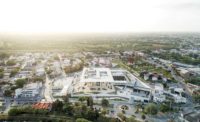U.S. Embassy Compound, Paramaribo
Paramaribo, Suriname
Best Project
Owner U.S. Dept. of State, Bureau of Overseas Buildings Operations
Lead Design Firm ZGF Architects LLP
Contractor BL Harbert International LLC
When Edwin R. Nolan, the U.S. ambassador to Suriname, held the embassy’s annual July 4 celebration this year in Paramaribo, it didn’t take place at the ambassador’s residence—where it has been held before—but at the new embassy complex, completed less than a year earlier. According to his prepared remarks, Nolan told the gathering, “I think that I speak for the entire embassy community when I say that we are very happy with, and proud of, our new embassy building and its beautiful campus setting.”
The team working on the new complex had to overcome weather, workforce and materials challenges, bringing in the $164-million project, including $120 million in construction costs, on budget and a month ahead of schedule.
One problem for the project team was rain. Suriname, located in northern South America, is in the Amazon rain forest, where the peak rainy season is between April and August. During most of the project’s construction period, the average monthly rain total was 16 in., but contractor BL Harbert International says the team was able to adapt quickly to the saturated conditions to finish earlier than the schedule.
There were also workforce issues. BL Harbert chose to self-perform more than 90% of the construction work but faced a lack of skilled trade workers and foremen. The company recruited a local workforce of more than 600. To train and oversee them, the company brought in a group of 130 experienced construction supervisors. They came from 18 countries, ranging from Cameroon to Canada.
One judge observed that it was “a challenging project, given the location and the limited pool of qualified workers. The project team and BL Harbert, in particular, provided a collaboration of local and international workers, designers and suppliers.”
Project managers emphasized safety. BL Harbert says, “Unlike the U.S., Suriname does not have nationalized safety standards.” The company hired a U.S. expatriate as safety and health manager, and its safety team supported and observed operations and mentored Surinamese workers. Further, the company had a safety incentive program. For example, supervisors could nominate workers for monthly awards. The results were a recordable incident rate of 1.15 and a lost-time rate of 0.08.
Pointing to the safety program, one Best Global Projects judge said, “I was impressed with the nontraditional safety considerations that were incorporated into this project. Providing a worker-safety incentive program, understanding the local challenges of a 60-hour work week and then providing buses, on-site lunches, and a fatigue-management plan all contribute to a safe work environment in creative, effective ways.”
Because some construction materials, such as reinforcing steel, paint and drywall, weren’t available locally, BL Harbert shipped more than 500, 40-ft containers by sea to Suriname from the company’s Birmingham, Ala., logistics center.
As Nolan noted in his July 4 speech, project officials placed a high priority on producing a building that was environmentally sustainable through features that save energy and reduce water use. For example, Nolan said the facility captures rainwater and treats it for potable and non-potable uses. The State Dept. anticipates that the project will receive a LEED Silver certification.
Judges also cited the project’s design, which was spearheaded by ZGF Architects LLP. One judge commented, “The project has created a beautiful facility for the U.S. Embassy personnel. Design and execution both add to the success of this project. Function and aesthetics are both fulfilled through an effective management and leadership team in both the U.S. and on site in Paramaribo.”
Related Article: Global Best Projects Awards 2017






Post a comment to this article
Report Abusive Comment